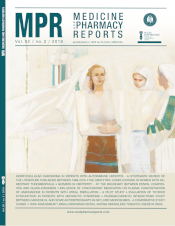Knowledge, attitude and practice regarding hypertension among residents in a housing area in Selangor, Malaysia
DOI:
https://doi.org/10.15386/mpr-1227Keywords:
healthy life style, cross-sectional studies, surveys and questionnaires, hypertension, MalaysiaAbstract
Background and aims. Hypertension is becoming a global epidemic and threat to the world population. This cross-sectional study was carried out at a housing area in Selangor, Malaysia to study the knowledge, attitude and practice (KAP) regarding hypertension among the residents.
Methods. A total of 110 respondents aged 18 years old and above were selected by convenience sampling. Data was collected using a structured interviewer-guided questionnaire with Likert-scale choices of answers.
Results. All respondents were Malay with the mean age of 41 years [Standard Deviation (SD)=11.828]. The total mean and SD of knowledge, attitude and practice scores were 74.33 (SD=6.25), 44.22 (SD=5.05) and 27.55 (SD=2.86), respectively. There were significant positive correlations between knowledge with attitude (r=+0.393; p<0.001) and practice (r=+0.378; p<0.001). However, there was no significant correlation between attitude and practice (r=+0.120; p=0.212). There were significant fair positive correlations between age with knowledge (r=+0.402; p<0.001), attitude (r=+0.265; p=0.005) and practice (r=+0.337; p<0.001) regarding hypertension. Meanwhile, gender, educational level, employment status and family history had no significant association with knowledge, attitude and practice regarding hypertension.
Conclusion. This study revealed that KAP regarding hypertension were associated with age, but not with other socio-demographic characteristics studied. The awareness, prevention and control programs of hypertension in their community should be increased, so that the residents could enjoy and maintain the healthy lifestyle.
Downloads
Published
How to Cite
Issue
Section
License
The authors are required to transfer the copyright of the published paper to the journal. This is done by agreeing to sign the Copyright Assignment Form. Whenever the case, authors are also required to send permissions to reproduce material (such as illustrations) from the copyright holder.

The papers published in the journal are licensed under a Creative Commons Attribution-NonCommercial-NoDerivatives 4.0 International License.

